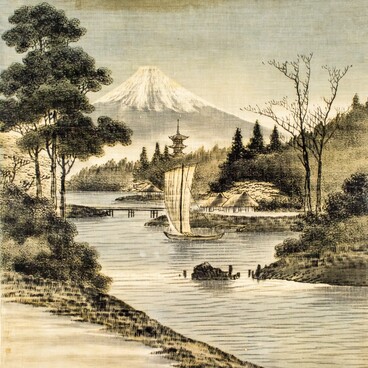A postcard from 1912 shows the city wharf on the Volga river.
The Tetyushi fortress, which has come to be known as the Tetyushi outpost, was built in 1574 — 1578. Another theory is that it was built even earlier, in 1557. The outpost was situated on the right bank of the Volga River. Tetyushi was the first Russian city to be founded on the Mid -Volga, downstream from the city of Kazan, immediately after its capture by Ivan the Terrible’s troops. The strategically important outposts and trading cities such as Samara, Saratov, and Tsaritsyn were founded on the Volga River after Tetyushi.
In the meantime, fortification (the Karlinsky line and the Old Tetyushi Zaseka) were built near the city and the elements of which have survived to this day. From the middle of the 17th century, Tetyushi lost the military significance, since it was replaced by Simbirsk, built in 1648, and the Simbirsk line was built instead of the Tetyushi Zaseka.
There are several versions of the origin of the town’s name. One view holds that Tetyushi was founded on the place of the Bulgar tribe Temtyuzi settlement. According to other theories, the name came from the Bulgar word “Ties-tue”, which meant “Nut Mountain”. It was also associated with the Orel dialect word " tetyushkat' " (to nurse) or Vyatka “tesha” (a fat man). Some scientists believe that the city’s name came from the Tatar khan Tetyusha, who escaped from Great Bulgaria after it had been burnt and founded the city on the right bank of the Volga River.
In the late 16th early 17th century the small uyezd town of Tetyushi became an important trade and economic center of the uyezd due to its favorable location. The town quickly became a local leader in grain, bread, and fish sales. Citizens of the uyezd were hired on cargo boats and transport ships; they worked at the wharfs, specifically during the summer and autumn fairs. Kazanskaya and Vozdvizhenskaya fairs were the largest.
In the Tetyushi district, there were seven wharves on the Volga River embankment. One of them was called Khlebnaya wharf. Tetyushi merchants purchased bread all over the uyezd and sent it to Nizhny Novgorod and Rybinsk cities. Up to 24 steamboats moored at the wharves every day.
All the wharf constructions and the surrounding area primarily belonged to small business owners from the merchants. For example, the wharf’s 22 granaries and stores out of 24 ones were in the hands of merchants.
The Tetyushi fortress, which has come to be known as the Tetyushi outpost, was built in 1574 — 1578. Another theory is that it was built even earlier, in 1557. The outpost was situated on the right bank of the Volga River. Tetyushi was the first Russian city to be founded on the Mid -Volga, downstream from the city of Kazan, immediately after its capture by Ivan the Terrible’s troops. The strategically important outposts and trading cities such as Samara, Saratov, and Tsaritsyn were founded on the Volga River after Tetyushi.
In the meantime, fortification (the Karlinsky line and the Old Tetyushi Zaseka) were built near the city and the elements of which have survived to this day. From the middle of the 17th century, Tetyushi lost the military significance, since it was replaced by Simbirsk, built in 1648, and the Simbirsk line was built instead of the Tetyushi Zaseka.
There are several versions of the origin of the town’s name. One view holds that Tetyushi was founded on the place of the Bulgar tribe Temtyuzi settlement. According to other theories, the name came from the Bulgar word “Ties-tue”, which meant “Nut Mountain”. It was also associated with the Orel dialect word " tetyushkat' " (to nurse) or Vyatka “tesha” (a fat man). Some scientists believe that the city’s name came from the Tatar khan Tetyusha, who escaped from Great Bulgaria after it had been burnt and founded the city on the right bank of the Volga River.
In the late 16th early 17th century the small uyezd town of Tetyushi became an important trade and economic center of the uyezd due to its favorable location. The town quickly became a local leader in grain, bread, and fish sales. Citizens of the uyezd were hired on cargo boats and transport ships; they worked at the wharfs, specifically during the summer and autumn fairs. Kazanskaya and Vozdvizhenskaya fairs were the largest.
In the Tetyushi district, there were seven wharves on the Volga River embankment. One of them was called Khlebnaya wharf. Tetyushi merchants purchased bread all over the uyezd and sent it to Nizhny Novgorod and Rybinsk cities. Up to 24 steamboats moored at the wharves every day.
All the wharf constructions and the surrounding area primarily belonged to small business owners from the merchants. For example, the wharf’s 22 granaries and stores out of 24 ones were in the hands of merchants.



